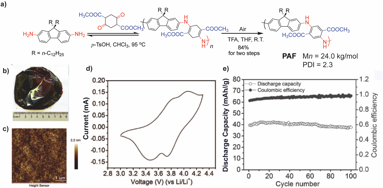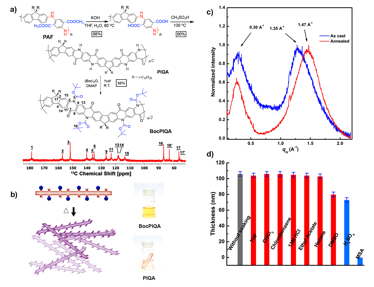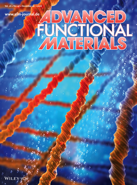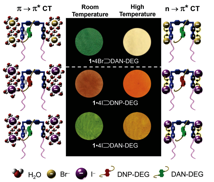Reports: DNI754249-DNI7: Bottom-Up Synthesis of Freestanding Two-Dimensional Polymers with Long-Range Order
Lei Fang, PhD, Texas A&M University
Introduction
Two-dimensional (2D) materials have drawn significant attention in scientific research because of their excellent chemical and physical properties. Despite the great amount of efforts have been made, however, this research field remains limited by the challenges on the large-scale production and the challenges on developing new materials with structural/functional versatility. In the past year, we have been making progress on tackling the challenges of intermolecular interaction of polymers gearing towards the formation of 2D polymers. These 1D polymers are conjugated so that they show promising potentials in widely advanced applications in the fields of electronics, optics and energy. Among this class of functional materials, conjugated ladder polymers, with fused ring constitution and fully rigid conformation, acquire unique mechanical and electronic properties and are promising candidate to be assembled into 2D sheets. However, great challenges remain in the precise structure control and convenient processing, mainly due to their insoluble nature. We accomplished study on a conjugated poly(aniline-co-fluorene) material and its application as a reversible battery cathode. With further modification, the efficient synthesis, characterization, and solution processing of a H-bonded ladder polymer were successfully achieved, which shows potentials in applications under extreme operating conditions. In addition, the self-assembly of molecular building blocks into higher order supramolecular structures are achieved and demonstrated remarkable thermochromic functions.
1. Poly(aniline-co-fluorene) for lithium ion battery application
The poly(aniline-co-fluorene) (PAF) material was synthesized by a multigram-scale one-pot polycondensation between diaminofluorene and dimethyl succinyl succinate (DMSS) followed by a in-situ oxidation reaction. After a detailed condition screening, the optimized condition was found as using chloroform as the solvent and p-tolysulfonic acid as the catalyst at the temperature of 95˚C (Figure 1a). Long alkyl chain functioned fluorene units endow good solubility during the polymerization as well as the solution processing and the PAF product showed excellent film forming property. Large-scale thin films can be processed easily by solvent evaporating or spin-coating with smooth amorphous surfaces (Figure 1b,c). Multi-electron transfer was observed by cyclic voltammetry (Figure 1d). Due to the synergistic electrochemistry between aniline and fluorene units, a high doping level of 0.69 was achieved. In a lithium ion flat cell battery with PAF/carbon composite as the cathode, the good electrochemical stability of PAF contributed to the little capacity decay (less than 5%) after a hundred cycles (Figure 1e). Meanwhile, its good intrinsic electron conductivity ensured little capacity loss in thicker electrodes.
Figure 1. a) Synthesis scheme of PAF; b) Large-scale PAF prepared by solvent evaporation; c) AFM image of spin-casted PAF on silicon; d) Cyclic voltammogram of PAF/carbon composite (PAF-33) with 33%wt PAF; e) Cycling stability test at 1 C for 100 cycles.
2. A hydrogen-bonded ladder polymer derived from quinacridone
High efficient and feasible ring annulation was conducted on hydrolyzed derives of PAF in methanesulfonic acid (MSA), affording an indenoquinacridone derived ladder polymer (PIQA). To further characterize this insoluble material, a tert-butyloxycarbonyl (boc) protecting strategy was employed to convert PIQA into a soluble derivative BocPIQA. Through solution phase characterization such as 13C NMR, the ladder-type structure was confirmed unambiguously. Uniform thin films can be obtained easily by solution processing of BocPIQA which can be converted back to PIQA by thermal annealing, which was confirmed by solid-state characterization including infrared transform infrared spectroscopy (FTIR) and grazing incidence wide angle X-ray scattering (GIWAXS). Thanks to the high rigidity of the ladder-type backbones and inter-chain H-bonds, the PIQA film demonstrated high thermal stability and excellent solvent-resistance in various aggressive chemical environments. This synthetic and side-chain engineering approach opens up the possibility of design and production of highly rigid, strong self-associated polymer materials with unprecedented properties.
Figure 2. a) Synthetic scheme of PIQA and BocPIQA. A clear 13C NMR spectrum of BocPIQA demonstrates the well-defined chemical constitution; b) Graphical representation of regenerating PIQA thin film from a BocPIQA precursor film; c) GIWAXS of as cast BocPIQA thin film and PIQA thin film generated from thermal annealing; d) Thickness of PIQA thin films after soaking in boiling solvents (red bars) or room temperature solvents (blue bars) demonstrating the remarkable solvent resistance.
3. Developing versatile thermochromic supramolecular materials3
Figure 3. (Left) Conceptual art representation of the supramolecular thermochromic fibers (Right) molecular mechanism and the thermochromic response of the supramolecular polymer fibers.
Stimuli-responsive supramolecular materials are of paramount importance for a broad range of applications. It is essential to impart versatility, sustainability, and scalability into these materials. In coloration with Dr. Mark Olson at Tianjin University, we designed and synthesized a new class of thermochromic supramolecular materials, which can easily be assembled in water via a reversible sol–gel transition. These materials can also be solution processed into different forms, e.g. thin films, aerogels and colored patterns, with thermochromic property. Since the behavior of these thermochromic supramolecular materials are based on the competing π → π* and n → π* charge transfer interactions, we could tune their thermochromic response. By using different π-electron rich donors, and counterions, we successfully tailored both the color observed at room temperature and at high temperatures. This work lays the foundation for synthesizing a series of supramolecular materials exhibiting tunable thermochromic properties, with hue variation based on a myriad of potential π-electron donor, acceptor and counterion combinations.















